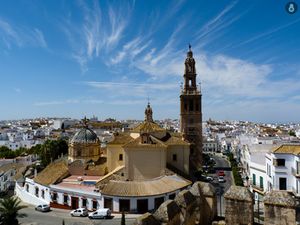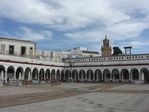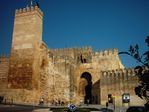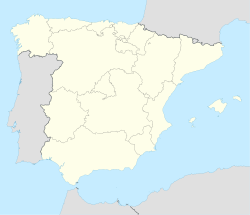قرمونة
قرمونة
Carmona | |
|---|---|
|
القصر وبوابة المدينة Puerta de Sevilla في قرمونة | |
| الإحداثيات: 37°28′N 5°38′W / 37.467°N 5.633°W | |
| البلد | |
| الإقليم الذاتي | |
| المقاطعة | إشبيلية |
| كوماركا | Campiña de Carmona |
| الحكومة | |
| • العمدة | Antonio Cano Luis (PSOE) |
| المساحة | |
| • الإجمالي | 924٫12 كم² (356٫80 ميل²) |
| المنسوب | 253 m (830 ft) |
| التعداد (2011) | |
| • الإجمالي | 28٬679 |
| • الكثافة | 31/km2 (80/sq mi) |
| صفة المواطن | Carmonense or Carmonés |
| منطقة التوقيت | UTC+1 (CET) |
| • الصيف (التوقيت الصيفي) | UTC+2 (CEST) |
| Postal code | 41410 |
| الموقع الإلكتروني | Official website |
قَرْمُونَة[1] (بالإسبانية: Carmona) مدينة بمقاطعة إشبيلية من منطقة الأندلس ذاتية الحكم بجنوب إسبانيا.
It is ascribed both to the comarca of Campiña de Carmona and the comarca of Los Alcores.[2]
الجغرافيا
الموقع
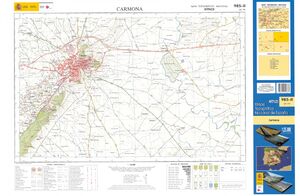 Sheet of the IGN's National Topographical Map of Spain (2010) corresponding to Carmona (1:25000). |
تقع قرمونة في جنوب غرب شبه جزيرة أيبيريا. It lies at about 249 metres above sea level,[3] on a NE–SO ridge at the northeastern end of Los Alcores tableland,[4] dominating over the meadows of the Corbones river,[5] a left-bank tributary of the Guadalquivir.
المناخ
Carmona has a Mediterranean climate with a sunny spring and typically some rain in that season. In October, the average temperature ranges from a minimum of 13 °C to a maximum of 26 °C. The city experiences a moderate level of annual precipitation and has pleasant winter temperatures.
التاريخ
Carmona was originally a Tartessian-Turdetani settlement. With the arrival of Phoenician traders from Tyre, Carmona was transformed into a city, known by them Qrt-Ḥmn (Phoenician: 𐤒𐤓𐤕 𐤇𐤌𐤍), meaning "City of Hammon".[6][مطلوب مصدر أفضل] Centuries later, it became a Roman stronghold of Hispania Baetica. It was known as Carmo in the time of Julius Caesar (100–44 BC). The city was further fortified during the long occupation of the Moors, who erected walls around it, and built fountains and palaces within.

كانت مقرا لإمارة إباضية في العهود الإسلامية بالأندلس، فقد اتخذها بنو برزال مقرا لهم.[7]
Following the demise of the Caliphate of Córdoba in the early 11th century, Carmona (Qarmūna) was seized by Hammudid Berbers, and then by the also Berber Birzalid clan, becoming the head of the طائفة قرمونة، a petty kingdom, which was conquered by the Abbadid taifa of Seville by 1067.[8] An Almoravid stronghold after the Almoravid conquest of the taifa of Seville, it was finally subdued by the Almohads after a settlement.[9] It was briefly occupied by Ibn Hamusk, before reverting to the Almohads in 1161.[10]
In 1247, Ferdinand III of Castile captured the town,[10] and bestowed on it the Latin motto Sicut Lucifer lucet in Aurora, sic in Wandalia Carmona ("As the Morning-star shines in the Dawn, so shines Carmona in Andalusia").[11] During the Late Middle Ages, the town preserved a Muslim-majority population ruled by a Christian minority.[12] The citadel of Carmona, now in ruins, was the principal fortress of Peter the Cruel (from 1350 to 1369), and contained a spacious palace within its defences.[11] Towards the end of the 15th century Carmona had an estimated population of about 8,000.[13] By the dawn of the Early Modern period, Carmona's economy was agriculture-based, with the town featuring many latifundia, often entitled to non-local landowners, and a substantial fraction of non-active population.[14]
The 19th century desamortizaciones led to the creation of a new landowning class that came to be historiographically designated as "agrarian bourgeoisie".[14] The population boomed in the mid 20th century.[14]
معرض
انظر أيضاً
المراجع
- ^ «من إشبيلية إلى مدينة قرمونة مرحلة، ومن قرمونة إلى مدينة إستجة مرحلة». الإدريسي، نزهة المشتاق في اختراق الآفاق.
- ^ Gómez, Noelia (2 October 2020). "Los pueblos más bonitos de Sevilla". El Español.
- ^ "Predicción por municipios. Carmona (Sevilla)". AEMET. Retrieved 21 April 2021.
- ^ "Perfil urbano de Carmona. Los Alcores y Vega de Carmona" (PDF). Catálogos de Paisaje de Andalucía. Seville: Centro de Estudios Paisaje y Territorio. Retrieved 21 April 2021.
- ^ "Carmona, la "joya" de la campiña sevillana". Europa Press. 1 October 2009.
- ^ John Everett-Heath (19 September 2019). The Concise Dictionary of World Place-Names. OUP Oxford. p. 792. ISBN 978-0-19-260254-1.
- ^ «بوابة الحركات الإسلامية»
- ^ Ramírez del Río 1999, p. 18.
- ^ Ramírez del Río 1999, pp. 18–19.
- ^ أ ب Ramírez del Río 1999, p. 19.
- ^ أ ب خطأ استشهاد: وسم
<ref>غير صحيح؛ لا نص تم توفيره للمراجع المسماةEB1911 - ^ Romero Moragas 2004, p. 763.
- ^ Ladero Quesada 1987, p. 73.
- ^ أ ب ت Romero Moragas 2004, p. 764.
وصلات خارجية
- Tourism Office
- Carmona Film Office (بالإسپانية)
- Museum of the city of Carmona (بالإسپانية)
- Pgou of the city (بالإسپانية)
- Short description is different from Wikidata
- Pages using gadget WikiMiniAtlas
- Articles with hatnote templates targeting a nonexistent page
- Articles containing Phoenician-language text
- Pages using Lang-xx templates
- كل المقالات بدون مراجع موثوقة
- كل المقالات بدون مراجع موثوقة from August 2021
- Articles containing لاتينية-language text
- السياحة في اسبانيا
- بلديات إشبيلية
- بلديات إسبانيا
- مواقع رومانية في اسبانيا
- مواقع أثرية في اسبانيا
- مسارح مفتوحة رومانية في اسبانيا


